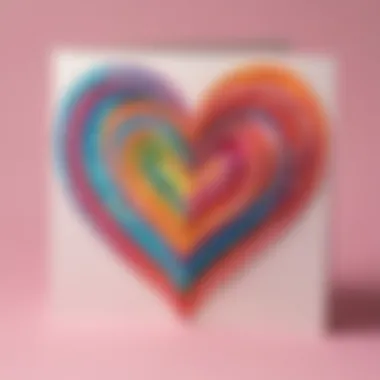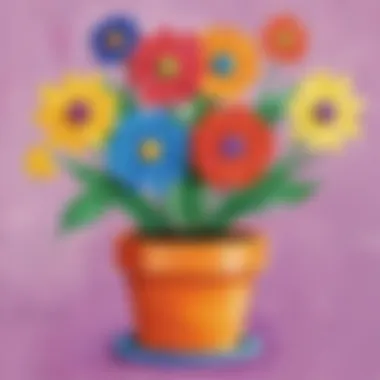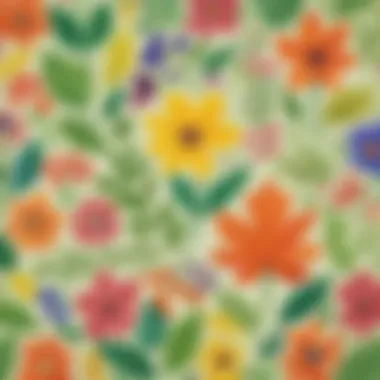Creative Mother's Day Art Projects for Preschoolers


Intro
Mothers Day is a special moment to celebrate the love and dedication of mothers. For preschoolers, expressing this affection can often emerge through art. Engaging in creative projects not only offers a platform for self-expression but also enhances their developmental skills. Throughout this article, we will explore a series of creative art projects that preschoolers can easily undertake. From simple crafts to meaningful activities, each project aims to nurture creativity while celebrating maternal bonds.
Creative Activities
When it comes to art projects for preschoolers, the focus should be on simplicity and accessibility. Here are some craft ideas that children can replicate while gaining enjoyment and learning.
Craft Ideas
- Handprint Flower: Use non-toxic paints for children to create flowers using their handprints. This craft allows them to connect body movement with artistic expression.
- Mother's Day Card: Utilizing cardstock, crayons, and stickers, children can make personalized cards. This encourages them to think about what they love about their mothers.
- Heart Shaped Collage: Collect various materials like fabric scraps, paper, and buttons to create a heart collage. This fosters resourcefulness and imagination.
Step-by-Step Guides
To better assist parents and educators, detailed instructions are crucial:
- Handprint Flower
- Mother's Day Card
- Heart Shaped Collage
- Gather paint and a large piece of paper.
- Have the child dip their hand in paint.
- Press their hand onto the paper to make a flower shape.
- Add a stem and leaves using a brush.
- Fold the cardstock in half.
- Let the child draw or paint a message for their mother.
- Use stickers to decorate the card.
- Draw a heart shape on a larger paper or cardboard.
- Provide various materials and glue.
- Let children fill in the heart with their chosen items.
Educational Value
Participating in these creative activities offers numerous benefits:
- Fine Motor Skills: Manipulating materials enhances dexterity.
- Color Recognition: Children learn to identify colors through various art supplies.
- Emotional Expression: Art allows young children to convey feelings they may not verbalize.
Crafting is a powerful outlet for self-expression, particularly for young minds navigating complex feelings.
For children, the act of creating becomes an opportunity to show appreciation through art. The process enriches their understanding of their mothers while cultivating a love of artistic endeavors.
As this article unfolds, you will discover more innovative projects and essential insights to support young artists.
Intro to Mothers Day Art Projects
Creating art projects for Mother's Day is a significant way to engage preschoolers in expressing their feelings. This section explores how art can serve as a vehicle for emotional expression and the nurturing of creativity in young children. It also emphasizes the importance of celebrating mothers through thoughtful and imaginative activities.
Significance of Mothers Day
Mother's Day holds immense significance across various cultures. It is a day dedicated to honoring the contributions of mothers and mother figures. Celebrating this occasion helps children recognize the love, support, and sacrifices made by their mothers. It lays the foundation for developing a sense of gratitude and appreciation. Encouraging children to create gifts or art projects for their mothers reinforces these values. These activities underline emotional connections and relationships, fostering understanding and respect.
Role of Art in Early Childhood Development
Art plays a vital role in early childhood development. It allows preschoolers to explore their creativity and imagination. Engaging in art activities helps children hone fine motor skills, as painting, drawing, and crafting involves the use of hands and coordination. Moreover, art provides a means of emotional expression when words may fail. Children can illustrate their feelings through colors, shapes, and patterns.
Additionally, art encourages cognitive development. By making choices about colors and materials, preschoolers stimulate problem-solving abilities. This engagement also enhances their ability to focus and pay attention to detail.
In essence, art projects for Mother's Day become a structured yet free outlet for preschoolers to explore and express themselves. This interaction can enrich their relationships with their mothers and nurture their artistic skills.
Understanding Preschoolers' Creative Process
Understanding the creative process of preschoolers is vital in the context of Mothers Day art projects. At this age, children engage in various forms of creativity that contribute significantly to their growth. Recognizing how preschoolers express themselves creatively can help educators and parents choose the right projects.
Art projects encourage cognitive exploration. When young children create, they experiment with colors, textures, and shapes. They develop their problem-solving skills as they figure out how to turn their ideas into tangible forms. This process helps them make sense of the world around them. It also provides a means for them to communicate their thoughts and experiences in a visual way.
Additionally, engaging in art allows preschoolers to refine their motor skills. Using scissors, crayons, and paintbrushes improves hand-eye coordination. This is crucial for their overall development. Moreover, art projects can enhance their ability to focus and follow multi-step directions, which are essential skills they will build on as they grow.


Cognitive Development in Art Activities
Art activities play a vital role in cognitive development for young children. Through creative tasks, children learn to categorize colors and shapes. They also engage in imaginative play, which allows them to invent scenarios and characters. This fosters both analytical thinking and creativity.
For example, a simple project like creating handprint flowers allows children to understand counting as they add petals or leaves. They might also discuss colors, sizes, and patterns while creating their flower arrangements, further stimulating their cognitive abilities. Encouraging children to ask questions during the activity can also boost their critical thinking skills.
Understanding that each child’s cognitive development occurs at their own pace is key. Some children may grasp concepts quickly, while others need more time. It is beneficial to provide varied art opportunities that cater to different levels of understanding.
Emotional Expression Through Art
Art serves as a powerful outlet for emotional expression in preschoolers. Children often have complex feelings that they might not be able to articulate with words. Art projects give them a medium to express joy, sadness, or even frustration. For Mothers Day, this becomes particularly relevant, as children create pieces to express love and appreciation for their mothers.
When children draw or paint, they learn to connect their emotions with their creative choices. For instance, using bright colors can represent happy feelings, while darker shades might indicate sadness. This process of translating emotions into art is beneficial for their emotional literacy. It helps them understand their feelings and can even be therapeutic.
Involving children in discussions about their creations further enhances this emotional learning. Asking open-ended questions about what they made and why allows them to explore their emotions in a supportive environment. This kind of dialogue encourages introspection and emotional intelligence, which are crucial for their personal development.
Understanding the creative process of preschoolers not only enriches their artistic skills but also supports their overall developmental journey.
Through art, preschoolers navigate cognitive and emotional landscapes, making it essential for parents and educators to support their journey. Recognizing these elements in the context of Mothers Day projects highlights the profound impact of creativity on young minds.
Selecting the Right Materials
Selecting appropriate materials is crucial for successful preschool art projects. The right supplies not only enhance creativity but also improve the learning experience for children. When preschoolers engage in art, the materials they use can influence their ability to express themselves and learn different concepts. Consideration of safety, accessibility, and sensory experience is essential in the selection process.
Basic Art Supplies for Preschoolers
Basic art supplies are essential in laying a foundation for preschoolers' creative explorations. These supplies should be safe and easy to handle. Here are some of the vital items to consider for the projects:
- Non-toxic Crayons: Crayons come in various colors and are simple for young hands to grip. They help children practice motor skills.
- Watercolor Paints: Watercolors allow for easy blending and mixing. They can create beautiful effects and are washable.
- Construction Paper: This paper is sturdy for crafting and comes in many colors, providing options for various projects.
- Glue Sticks: Glue sticks are less messy compared to liquid glue and can be easily used by small hands.
- Safety Scissors: These scissors are designed for preschoolers to cut paper safely, improving hand-eye coordination.
Having these items readily available can encourage children to experiment and create freely.
Incorporating Recyclable Materials
Recyclable materials are an excellent addition to any art project. They provide a unique opportunity for children to reuse items that would typically be discarded. Using these materials teaches children about sustainability and environmental responsibility. Here are some popular recyclable materials to consider:
- Cardboard Boxes: These can be transformed into sculptures or masks. They promote imaginative play.
- Plastic Bottles: Bottles can be cut and painted, allowing children to create flowers or unique structures.
- Old Magazines: Kids can cut out pictures and images for collages. It helps in developing fine motor skills.
- Egg Cartons: These can become creatures or art supplies carriers, depending on how kids choose to elevate them.
By integrating recyclables, children learn to think creatively and resourcefully. It can also spark discussions about recycling and the importance of taking care of our planet.
"Choosing the right materials encourages creative expression and essential learning experiences for preschoolers."
The thoughtful selection of art supplies fosters an environment where preschoolers can thrive artistically while learning valuable skills. Thus, acknowledging this aspect is crucial in planning effective Mothers Day art projects.
Mothers Day Art Project Ideas
Engaging preschoolers in art projects for Mother's Day is both a meaningful and rewarding experience. These activities allow young children to express their admiration and love for their mothers through creativity. It helps strengthen the emotional bond they share while allowing them to experience the joy of creating something special. Understanding the art projects can also enhance their fine motor skills, hand-eye coordination, and cognitive development. It builds their self-esteem as they take pride in completing their own work.
Handprint Flowers
Materials Needed
The materials for the handprint flowers are straightforward and accessible. You typically need construction paper, washable paint, and brushes. These materials are effective because they allow preschoolers to create something unique using their own hands, which adds a personal touch. The use of bright colors can capture a child’s attention, making this activity more enjoyable.
These materials also have the advantage of being easy to clean up. Using washable paint means less worry about stains, making it a less stressful experience for both children and adults.
Step-by-step Instructions
The step-by-step instructions for handprint flowers are simple enough, making it easy for preschoolers to follow. First, children dip their hands into paint before pressing them onto paper. The shape created represents petals. Once the handprints dry, they can use markers or additional paints to create stems and leaves.


This approach supports independence in crafting because children can lead the process themselves, which is essential for building confidence. The simplicity of this structure fosters a sense of achievement in young learners, motivating them to engage in more art activities.
Variations for Creativity
When considering variations for creativity, the possibilities are quite numerous. For instance, you can use different colors or even materials like glitter for added texture. Incorporating tools like sponges or forks can create unique patterns, turning a simple idea into something more intricate.
Encouraging variations lets children explore their imaginations and gives them the freedom to personalize their creations. These adaptations make projects more inviting and can lead to unexpected outcomes, enriching the children's understanding of artistic expression.
Personalized Photo Frames
Choosing the Right Frame
Choosing the right frame is key to making personalized photo frames for Mother's Day. The selection can vary from cardboard frames to wooden ones, but cardboard provides ease of use for preschoolers, allowing them to manipulate and decorate it with minimal difficulty. A simple base acts as a blank canvas, inviting children to unleash their creativity.
This accessibility is important as it encourages participation without the intimidation of more complex tools. It allows for a successful experience, fostering positive feelings toward art-making.
Decoration Techniques
Decoration techniques for the frames can include painting, collage-making, and use of stickers. These techniques are straightforward enough for preschoolers to grasp while introducing them to important artistic concepts. They learn to express their feelings through color choices and mediums.
These techniques can be instrumental in reinforcing the joy of self-expression. Kids will take pride in their handiwork, developing a sense of accomplishment.
Adding Personal Touches
Adding personal touches, such as names, dates, or hand-drawn designs, transforms a generic photo frame into a cherished keepsake. This step allows children to infuse their unique personality into their art piece, making it an intimate gift for their mothers.
Doing so emphasizes the importance of individuality and expression, showing children that their creativity matters. Such personal touches can significantly enhance the emotional impact of the gift.
Custom Mother's Day Cards
Designing the Card
Designing the card involves choosing the type of fold and surface area for decoration. Preschoolers can use folded construction paper to create unique designs. Utilizing different colored papers encourages creativity and helps them understand aesthetic arrangements.
The simplicity of card design ensures that kids can feel ownership over their creation, which is vital for building confidence in their artistic abilities.
Incorporating Messages
Incorporating messages adds a special layer of significance to the custom cards. Encouraging children to write or dictate letters expressing their feelings allows them to practice language skills and thoughtful communication.
This process helps develop their vocabulary and understanding of emotional expression, which strengthens their relationship with their mothers.
Presentation Ideas
Presentation ideas can include decorating the outside of the envelope or using creative ways to give the card. For instance, they could present it at a special time, like during a family meal or cuddle time. Simple yet thoughtful presentations enhance the experience, raising the significance of the work produced.
Nature-inspired Art Projects
Collecting Materials from Nature
Collecting materials from nature engages preschoolers in a real-world exploration. Gathering leaves, flowers, or small twigs supports sensory experiences, from touch to visual engagement. This encourages children to appreciate their surroundings, which is also significant for their environmental awareness.
The process can teach them about seasonal changes and natural beauty, solidifying their connection to the earth.
Creating Nature Collages
Creating nature collages promotes creativity by letting preschoolers combine their collected materials onto a canvas. This process enhances fine motor skills and encourages artistic expression. Understanding composition and layering helps in cognitive development, showcasing the connection between art and learning.
This project allows for adjustments and creative decisions, giving children room to innovate.


Environmental Awareness Discussion
The discussion about environmental awareness can stem from the nature projects. Educators and parents can discuss why it’s important to take care of nature and its role in our lives. Such conversations create well-rounded individuals who understand the value of preservation and stewardship, broadening their perspectives beyond immediate art-making to include larger social issues.
Involving Parents in the Creative Process
Involving parents in the creative process is an essential aspect of preschoolers engaging in art projects for Mother’s Day. When parents participate, the experience becomes more meaningful for the child. This involvement fosters a supportive atmosphere that encourages artistic exploration. Moreover, it enhances the emotional connection between the child and their parent, allowing for shared memories that can strengthen their bond. Through this collaborative effort, parents can also gain insights into their child's interests and skills, promoting further development in those areas.
Encouraging Participation
To encourage participation, educators should create an environment that welcomes parent involvement. This can be achieved by organizing workshops that introduce various art techniques. Sharing project ideas and the necessary materials with parents can also motivate them to join in. Implementing family art days can further facilitate engagement. During these events, kids can show their parents fun projects they are working on, such as handprint flowers or custom cards for Mother’s Day. Parents will likely feel more inclined to participate if they see the joy it brings to their child.
Sharing Completed Projects
Sharing the completed projects is a rewarding experience for both preschoolers and their parents. When children showcase their work, it creates an opportunity for them to express pride in their accomplishments. This can involve displaying the art pieces at home or organizing a small exhibition at the preschool. Parents can also help document the process by taking photos, which they can share on social media platforms or within their personal circles. This not only celebrates the child's efforts but also encourages a dialogue about the creative journey, reinforcing the skills and emotions involved in art-making.
"Art is a journey, not a destination. Involving parents in this journey enhances the experience for young artists."
Through these avenues, parents can play an integral role, highlighting the importance of collaboration in creative expression. Engaging together in artwork nurtures both the parent-child relationship and the child's creative development.
Addressing Challenges in Art Projects
Creating art with preschoolers can be an enriching experience, but it comes with its own set of challenges. Addressing these challenges not only enhances the creative process but also supports the overall development of the child. Understanding these difficulties enables both parents and educators to foster a more engaging and productive environment. Whether it be messiness or striking a balance between independence and needed guidance, these factors play a vital role in the artistic journey of young children.
Managing Messiness in Art
Messiness is perhaps the most immediate concern when engaging preschoolers in art projects. As they explore colors, textures, and materials, the process can quickly become chaotic. However, it is essential to recognize that this messiness is a natural aspect of creativity.
- Preparation is Key: Before starting an art project, ensure the area is adequately covered with newspapers or old tablecloths. This can make cleanup easier and may reduce anxiety about potential damage to surfaces.
- Choose Washable Materials: Utilizing materials that can be easily cleaned up, such as washable paints and non-toxic markers, helps minimize stress regarding stains.
- Set Boundaries: While allowing children the freedom to express themselves, set clear boundaries about where materials can be used that foster responsibility.
- Incorporate Cleanup Activities: Turn cleaning up into part of the art project. Make it fun for the children to help organize materials or clean brushes. This teaches them accountability and the importance of maintaining their space.
By embracing messiness within structured limits, children can freely express themselves, enhancing their creativity while learning to take care of their environment.
Encouraging Independence vs. Guidance
Finding the right balance between encouraging independence and providing guidance is crucial in preschool art projects. On one hand, children need the space to experiment and try new things by themselves. On the other hand, some guidance is necessary to ensure they can complete the tasks successfully.
- Allow Personal Exploration: Give children the freedom to choose their colors and materials. Personal choice fosters a sense of ownership over their projects and enhances creative thinking.
- Provide Support When Needed: When children exhibit frustration, step in with gentle guidance. Offer suggestions or demonstrate techniques without taking over their project. This fosters their problem-solving skills while still allowing them to express their creativity.
- Encourage Decision-Making: Ask open-ended questions, such as "What do you think would happen if you mixed these two colors?" This prompts them to think critically about their art and empowers them to make choices independently.
- Create a Safe Space for Mistakes: Letting children know that mistakes are part of the learning process encourages risk-taking in art. Celebrating these moments can build their confidence.
Finding the equilibrium between independence and support helps children feel more secure in their creative endeavors. It allows them to develop their unique styles while learning from their experiences.
"Creativity is allowing yourself to make mistakes. Art is knowing which ones to keep." - Scott Adams
In summary, addressing the challenges in art projects is fundamental to enriching the preschool experience. By managing messiness and encouraging a healthy balance of independence and guidance, parents and educators can create a nurturing environment that promotes artistic exploration and emotional expression.
Closure
The conclusion of this article is crucial as it encapsulates the essence of the discussed themes and provide a roadmap for parents and educators alike. Mothers Day art projects serve not only as a celebration of mothers, but also as meaningful activities that contribute to the holistic development of preschoolers. Such projects encourage creativity, strengthen fine motor skills, and enhance emotional expression, providing children with platforms through which they can translate their feelings into beautiful creations.
In summary, creating art for Mothers Day engages children in diverse activities that stimulate both cognitive and emotional growth. As they navigate through various artistic endeavors, they learn important lessons about sharing, collaboration, and the value of personal expression. These skills are integral to their overall development and well-being.
The act of creating something heartfelt for their mothers teaches children gratitude and the importance of relationships. Parents who guide their children through these projects foster a connection that is rooted in creativity and shared experiences.
Summary of Key Points
- Importance of Creativity: Art projects inspire innovative thinking and problem-solving skills in preschoolers.
- Emotional Expression: Children express their feelings and thoughts through creative outlets.
- Parental Involvement: Parents play a pivotal role in guiding and supporting their children’s artistic efforts.
- Developmental Benefits: Engaging in art allows preschoolers to refine their fine motor skills, enhance cognitive development, and practice social skills.
- Significance of the Occasion: Mothers Day art projects provide an opportunity to celebrate and honor maternal figures, instilling values of appreciation and love in young minds.
Final Thoughts on Fostering Creativity
Fostering creativity in preschoolers requires intentional efforts from parents and educators. Providing children with the right materials and encouragement is paramount. By engaging children in art projects, we are giving them the tools to explore their imagination and express their individuality.
It’s essential to create an environment conducive to artistic expression; this can be achieved through open-ended prompts and ample supplies. Art projects can vary greatly, allowing children to explore various methods and materials. This, in turn, encourages their ability to experiment and find joy in creation.
"Creativity takes courage." - Henri Matisse
In closing, the joy and satisfaction children feel when completing a Mothers Day art project is invaluable. It is a process that contributes significantly to their growth, serving as a foundation for lifelong creative expression and emotional intelligence. The artistic skills they develop now will mold their capacity for self-expression in the future.







